Python 某电子产品销售数据分析报告及RFM模型(二)
关注微信公共号:小程在线整体数据关注CSDN博客:程志伟的博客6.1总的指标#6.1.1总GMV:约1.15亿元round(data['amount'].sum(),0)Out[4]: 114986636.0#6.1.2每月的GMV:#GMV8月之前都基本是处于上升状态,在7月8月的上升更是非常大,8月达到峰值,然后就开始下降了GMV_month = data.groupby('month').a
关注微信公共号:小程在线


整体数据
关注CSDN博客:程志伟的博客
6.1总的指标
#6.1.1总GMV:约1.15亿元
round(data['amount'].sum(),0)
Out[4]: 114986636.0
#6.1.2每月的GMV:
#GMV8月之前都基本是处于上升状态,在7月8月的上升更是非常大,8月达到峰值,然后就开始下降了
GMV_month = data.groupby('month').agg(GMV=('amount','sum'))
GMV_month
Out[5]:
GMV
month
1 1729464.93
2 2216672.31
3 2841015.58
4 1674450.68
5 7657332.51
6 7489312.32
7 16048807.99
8 27380899.66
9 16797132.61
10 19376572.75
11 11774974.54
plt.plot(GMV_month.index,GMV_month['GMV'])
plt.show()
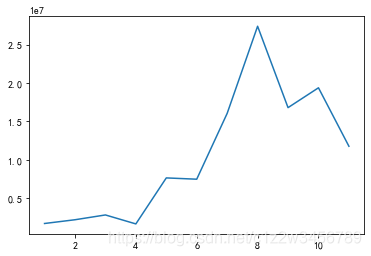
#6.1.3客单价:1240元
#按客户数量
round(data['amount'].sum() / data['user_id'].nunique(),0)
Out[7]: 1240.0
#按订单数量
round(data['amount'].sum() / data['order_id'].nunique(),0)
Out[8]: 296.0
####6.2用户分析
#6.2.1结论先行:
'''
各地区用户最多的是广东(21382),然后是上海(16031)、北京(15928),其他8个城市比较平均(在5400上下)
广东人口基数是全国最高的,而且目前广东的用户仅占广东人口总数的0.017%,最高用户占比是北京:0.0728%,约为广东的4倍,所以在广东投入拉新活动性价比是比较高的
男性和女性用户各占一半
年龄分布也平均,总体上是在16-50岁之间
'''
#转换为日期格式
data['date'] = pd.to_datetime(data['date'])
data.user_id.nunique()
Out[10]: 92755
#6.2.3各地区用户数量
local = data.groupby('local')['user_id'].nunique().reset_index()
local = local.rename(columns={'user_id':'用户数量'})
local = local.sort_values('用户数量').reset_index(drop=True)
local
Out[11]:
local 用户数量
0 湖南 5330
1 天津 5337
2 重庆 5342
3 湖北 5355
4 浙江 5370
5 四川 5445
6 海南 5449
7 江苏 5561
8 北京 15928
9 上海 16031
10 广东 21382
plt.figure(figsize=(10,8))
plt.ylabel('用户数量')
plt.title('各地区用户数量')
plt.bar(local['local'],local['用户数量'])
for x,y in enumerate(local['用户数量']):
plt.text(x,y+200,y,ha='center')
plt.show()

#广东的用户数量是最多的,然后就是北京和上海,其他八个城市用户比较平均,都是在5400左右。
#6.2.3.1根据2020年的全国人口普查,在网上得到了各省的人口数量数据,分析各省用户的占比,看看哪些省还可以进行用户拉新
population = pd.read_excel(r'F:\Python\合鲸社区\05-某电子产品销售数据分析报告及RFM模型\2020年各省人口数量.xlsx') #网上搜集的
population = population.iloc[:,:2]
population.head()
Out[13]:
地区 人口数
0 全国 1411778724
1 广东 126012510
2 山东 101527453
3 河南 99365519
4 江苏 84748016
local = pd.merge(local,population,how='inner',left_on='local',right_on='地区')
local['占比'] = local['用户数量'] / local['人口数']
local = local.sort_values('占比',ascending=False).reset_index(drop=True)
local
Out[15]:
local 用户数量 地区 人口数 占比
0 北京 15928 北京 21893095 0.00
1 上海 16031 上海 24870895 0.00
2 海南 5449 海南 10081232 0.00
3 天津 5337 天津 13866009 0.00
4 广东 21382 广东 126012510 0.00
5 重庆 5342 重庆 32054159 0.00
6 湖北 5355 湖北 57752557 0.00
7 浙江 5370 浙江 64567588 0.00
8 湖南 5330 湖南 66444864 0.00
9 江苏 5561 江苏 84748016 0.00
10 四川 5445 四川 83674366 0.00
从上表可以看到,用户数量占比前三是北京、上海、海南,第四是天津,广东排第五,广东的占比仅为第一名北京的五分之一,加上广东的人口数是最多的,所以在广东进行拉新活动的性价比是最高的
#6.2.4用户性别分布
sex = data.groupby('sex')['user_id'].nunique().reset_index()
sex.rename(columns={'user_id':'用户数量'},inplace=True)
sex
Out[16]:
sex 用户数量
0 女 47235
1 男 47628
plt.pie(sex['用户数量'],labels=sex['sex'],autopct='%1.2f%%')
plt.show()
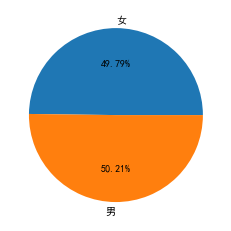
#6.2.5年龄分布
data.age.min()
Out[18]: 16.0
data.age.max()
Out[19]: 50.0
bins = [15,20,25,30,35,40,45,50]
labels = ['(15-20]岁','(20-25]岁','(25-30]岁','(30-35]岁','(35-40]岁','(40-45]岁','(45-50]岁']
data_ = data.copy()
data_['age_bin'] = pd.cut(x=data.age,bins=bins,right=True,labels=labels)
data_
Out[20]:
order_id product_id ... amount age_bin
0 2294359932054536986 1515966223509089906 ... 324.02 (20-25]岁
1 2294444024058086220 2273948319057183658 ... 155.04 (35-40]岁
2 2294584263154074236 2273948316817424439 ... 217.57 (30-35]岁
3 2295716521449619559 1515966223509261697 ... 39.33 (15-20]岁
4 2295740594749702229 1515966223509104892 ... 5548.04 (20-25]岁
... ... ... ... ...
536306 2388440981134693942 1515966223526602848 ... 138.87 (20-25]岁
536307 2388440981134693943 1515966223509089282 ... 418.96 (20-25]岁
536308 2388440981134693944 1515966223509089917 ... 12.48 (15-20]岁
536309 2388440981134693944 2273948184839454837 ... 41.64 (15-20]岁
536310 2388440981134693944 1515966223509127566 ... 53.22 (15-20]岁
[535065 rows x 17 columns]
age = data_.groupby('age_bin')['user_id'].nunique().reset_index()
age.rename(columns={'user_id':'用户数量'},inplace=True)
age
Out[21]:
age_bin 用户数量
0 (15-20]岁 13726
1 (20-25]岁 13867
2 (25-30]岁 13831
3 (30-35]岁 13802
4 (35-40]岁 13775
5 (40-45]岁 13969
6 (45-50]岁 13535
plt.figure(figsize=(10,4))
plt.bar(age['age_bin'],age['用户数量'])
plt.show()

用户年龄分布较平均,在16-50岁
data_.groupby('age')['user_id'].nunique().reset_index()
Out[23]:
age user_id
0 16.00 2797
1 17.00 2725
2 18.00 2759
3 19.00 2703
4 20.00 2838
5 21.00 2786
6 22.00 2792
7 23.00 2820
8 24.00 2764
9 25.00 2768
10 26.00 2793
11 27.00 2724
12 28.00 2825
13 29.00 2802
14 30.00 2755
15 31.00 2772
16 32.00 2841
17 33.00 2745
18 34.00 2738
19 35.00 2764
20 36.00 2805
21 37.00 2710
22 38.00 2820
23 39.00 2813
24 40.00 2685
25 41.00 2753
26 42.00 2763
27 43.00 2875
28 44.00 2854
29 45.00 2784
30 46.00 2713
31 47.00 2677
32 48.00 2781
33 49.00 2707
34 50.00 2724
#6.2.6各年龄段的消费金额及下单数量
发现35-40岁的用户,贡献的消费金额与下订单的数量都是最低的,其他年龄段比较平均
age_bin_data = data_.groupby('age_bin').agg(消费金额=('amount','sum'),下单次数=('order_id','nunique'))
age_bin_data
Out[24]:
消费金额 下单次数
age_bin
(15-20]岁 16007287.18 54302
(20-25]岁 16500743.70 55546
(25-30]岁 16513446.00 54723
(30-35]岁 17004578.70 58275
(35-40]岁 14995577.44 49744
(40-45]岁 17078724.54 59067
(45-50]岁 16886278.32 57085
fig,ax1 = plt.subplots(figsize=(16,8))
xticks = np.arange(len(age_bin_data.index))
ax1.bar(xticks,age_bin_data.消费金额,width=0.3,color='g')
ax1.set_ylabel('消费金额')
ax2 = ax1.twinx()
ax2.bar(xticks+0.3,age_bin_data.下单次数,width=0.3,color='b')
ax2.set_ylabel('下单次数')
plt.title('各年龄段的消费金额及下单次数')
ax1.set_xticks(xticks+0.15)
ax1.set_xticklabels(age_bin_data.index)
plt.show()
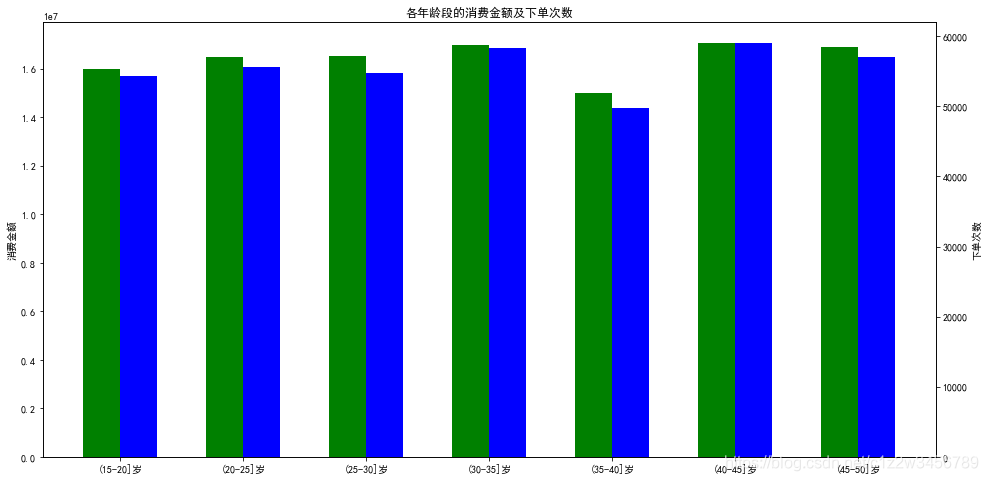
#6.2.7男性女性的消费金额及下单数量
#发现男性女性的消费金额与下单次数均比较平均
sex_data = data_.groupby('sex').agg(消费金额=('amount','sum'),下单次数=('order_id','nunique'))
sex_data
Out[26]:
消费金额 下单次数
sex
女 57108456.57 192394
男 57878179.31 196348
#6.2.8分析购买了0元产品的用户
#从产品的类别可以知道,0元的商品应该是抽奖活动中奖的
#中奖的30个用户中,仅有1个用户没有购买过其他商品,而且这30个用户的客单价高达34832元(总的客单价为1240元)
data[data['price']==0]
Out[27]:
order_id product_id ... buy_cnt amount
18846 2323108762694451619 1515966223509132095 ... 1 0.00
39974 2348769908982022577 2309018259719979217 ... 1 0.00
47017 2348779162900103916 2309018259719979217 ... 1 0.00
56572 2348791961667764924 2309018259719979217 ... 1 0.00
61602 2348798941820092785 1515966223509118512 ... 1 0.00
62416 2348799560932918101 2309018259719979217 ... 1 0.00
63934 2348801959043007423 1515966223509117560 ... 1 0.00
64171 2348802240422084738 2309018259719979217 ... 1 0.00
73950 2348816074318807631 2309018259719979217 ... 1 0.00
105538 2353232124972106231 2309018259719979217 ... 1 0.00
118650 2353259718920634989 2309018259719979217 ... 1 0.00
122452 2353267147829937068 2309018259719979217 ... 1 0.00
126484 2353276891760165720 2309018259719979217 ... 1 0.00
138497 2354499489466679644 1515966223509117182 ... 1 0.00
290457 2383131432571633684 2309018260114244280 ... 1 0.00
325835 2388440981134432748 2309018260114244280 ... 1 0.00
340713 2388440981134469495 2309018260114244280 ... 1 0.00
361988 2388440981134532738 2309018260114244281 ... 1 0.00
395362 2388440981134591174 2309018260114244281 ... 1 0.00
407040 2388440981134600026 2309018260114244280 ... 1 0.00
427892 2388440981134615512 2309018260114244280 ... 1 0.00
429370 2388440981134616477 2309018260114244280 ... 1 0.00
430578 2388440981134617284 2309018260114244280 ... 1 0.00
434932 2388440981134620423 2309018259719979217 ... 1 0.00
435548 2388440981134620837 2309018260114244281 ... 1 0.00
444242 2388440981134627558 2309018260114244280 ... 1 0.00
445869 2388440981134628677 2309018259719979217 ... 1 0.00
475017 2388440981134649580 2309018260114244281 ... 1 0.00
494181 2388440981134663702 2309018260114244281 ... 1 0.00
514493 2388440981134678374 2309018260114244280 ... 1 0.00
[30 rows x 16 columns]
#提取该批用户出来
user_0 = data[data['price']==0]['user_id'].reset_index(drop=True)
user_0
Out[28]:
0 1515915625468531712
1 1515915625484619520
2 1515915625484629760
3 1515915625446572032
4 1515915625484641280
5 1515915625484627200
6 1515915625484652288
7 1515915625484648960
8 1515915625446041088
9 1515915625446041088
10 1515915625512678912
11 1515915625486717696
12 1515915625479406336
13 1515915625449238016
14 1515915625498273536
15 1515915625498244096
16 1515915625498229248
17 1515915625505436160
18 1515915625512202240
19 1515915625512377088
20 1515915625512762368
21 1515915625512763136
22 1515915625512763904
23 1515915625512817664
24 1515915625512118784
25 1515915625498201088
26 1515915625513058048
27 1515915625467158528
28 1515915625514162432
29 1515915625514596864
Name: user_id, dtype: object
user_0.shape
Out[29]: (30,)
#30个中奖的用户中,只有一个用户没有产生消费
user_0[~user_0.isin(data[data['price']>0]['user_id'])]
Out[30]:
0 1515915625468531712
Name: user_id, dtype: object
data_user_0 = pd.merge(data,user_0,on='user_id')
data_user_0_amount = data_user_0.groupby('user_id').agg(消费金额=('amount','sum')).sort_values('消费金额',ascending=False)
data_user_0_amount
Out[32]:
消费金额
user_id
1515915625512377088 149967.06
1515915625512763904 109908.68
1515915625512763136 77031.07
1515915625514596864 76281.00
1515915625512817664 76046.94
1515915625512118784 65778.93
1515915625513058048 58286.07
1515915625512202240 52518.51
1515915625514162432 48217.85
1515915625484627200 46833.03
1515915625484652288 46558.67
1515915625484648960 42259.39
1515915625512762368 37710.57
1515915625484641280 26495.51
1515915625484629760 26273.05
1515915625484619520 25002.66
1515915625479406336 15143.98
1515915625486717696 14081.96
1515915625446572032 10451.64
1515915625498273536 8553.32
1515915625446041088 7726.76
1515915625512678912 6487.89
1515915625498201088 6020.53
1515915625498244096 3291.36
1515915625505436160 2908.19
1515915625498229248 2317.66
1515915625467158528 1925.24
1515915625449238016 893.42
1515915625468531712 0.00
#该批用户的客单价为34832元
data_user_0_amount['消费金额'].sum() / 30
Out[33]: 34832.36466666667
#6.2.9二八定律-找出累计贡献销售额80%的那批用户
#前27%的用户贡献了80%的销售收入,这批用户要做好跟进,一定要留住这批贡献大的客户
user_28 = data.groupby('user_id').agg(消费金额=('amount','sum')).sort_values('消费金额',ascending=False).reset_index()
user_28['累计销售额'] = user_28['消费金额'].cumsum()
user_28
Out[34]:
user_id 消费金额 累计销售额
0 1515915625512422912 160604.07 160604.07
1 1515915625513695488 158277.37 318881.44
2 1515915625512377088 149967.06 468848.50
3 1515915625513577472 135672.84 604521.34
4 1515915625514597888 133945.88 738467.22
... ... ...
92750 1515915625511079936 0.02 114986635.82
92751 1515915625450548736 0.02 114986635.84
92752 1515915625506653440 0.02 114986635.86
92753 1515915625451367168 0.02 114986635.88
92754 1515915625468531712 0.00 114986635.88
[92755 rows x 3 columns]
#前27%的用户贡献了80%的销售收入
p = user_28['消费金额'].cumsum()/user_28['消费金额'].sum() # 创建累计占比,Series
key = p[p>0.8].index[0]
key
Out[35]: 25408
key / user_28.shape[0]
Out[36]: 0.2739259339119185
plt.plot(user_28.index,user_28['累计销售额'])
plt.show()

#6.2.10客户消费金额的分位数
#用户平均消费金额大于75%分位数,即存在着高消费的客户
data.groupby('user_id').agg(消费金额=('amount','sum')).describe(percentiles=(0.01,0.1,0.25,0.75,0.9,0.99)).T
Out[38]:
count mean std min ... 75% 90% 99% max
消费金额 92755.00 1239.68 4129.72 0.00 ... 1141.17 2402.53 12744.87 160604.07
[1 rows x 12 columns]
#6.2.11客户消费周期
#消费了两次及以上的客户有50%的消费周期为7天内,用户的消费周期还是比较短的。75%为26天内,消费周期适中
purchase_day = data[data['amount']>0].sort_values('date').groupby('user_id').apply(lambda x: x['date'] - x['date'].shift()).dt.days
purchase_day
Out[39]:
user_id
1515915625439951872 90907 nan
1515915625440038400 357719 nan
461674 36.00
1515915625440051712 451057 nan
451029 0.00
1515915625514888704 536285 nan
536306 0.00
536275 0.00
1515915625514891008 536300 nan
1515915625514891264 536307 nan
Name: date, Length: 535035, dtype: float64
#6.2.12每月新客户、不活跃客户、回流客户、活跃客户的情况
purchase_day[purchase_day>0].describe(percentiles=[0.01,0.1,0.25,0.75,0.9,0.99])
Out[40]:
count 139989.00
mean 21.06
std 31.44
min 1.00
1% 1.00
10% 1.00
25% 2.00
50% 7.00
75% 26.00
90% 63.00
99% 146.00
max 299.00
Name: date, dtype: float64
pivoted_amount =data[data['amount']>0].pivot_table(index='user_id'
,columns='month'
,values='buy_cnt'
,aggfunc='sum').fillna(0)
columns_month = pivoted_amount.columns.astype('str') #一定要把列名格式变为str不然后面就会报错
pivoted_amount.columns = columns_month
pivoted_purchase = pivoted_amount.applymap(lambda x:1 if x>0 else 0)
def active_status(data):
status =[]
for i in range(11):
#若本月没有消费
if data[i] ==0:
if len(status)>0: #如果不是第一个月,
if status[i-1]=='未注册': #如果上个月已经是未注册,那么本月也是未注册
status.append('未注册')
else: #如果上月已注册,则本月为不活跃
status.append('不活跃')
else: #如果是第一个月
status.append('未注册') #则未注册
#若本月消费
else:
if len(status)==0: #如果是第一个月,则为新注册用户
status.append('新客户')
else: #如果不是第一个月
if status[i-1]=='不活跃': #如果上月为不活跃,那么本月为回流
status.append('回流')
elif status[i-1]=='未注册': #如果上月为未注册,那么本月为新注册
status.append('新客户')
else: #如果上月为活跃,本月也为活跃
status.append('活跃')
return pd.Series(status,index=columns_month)
pivoted_purchase_status = pivoted_purchase.apply(lambda x:active_status(x),axis=1)
pivoted_purchase_status.head()
Out[43]:
month 1 2 3 4 5 6 7 8 9 10 11
user_id
1515915625439951872 未注册 未注册 未注册 未注册 未注册 未注册 新客户 不活跃 不活跃 不活跃 不活跃
1515915625440038400 未注册 未注册 未注册 未注册 未注册 未注册 未注册 未注册 新客户 活跃 不活跃
1515915625440051712 未注册 未注册 未注册 未注册 未注册 未注册 未注册 未注册 未注册 新客户 活跃
1515915625440099840 未注册 未注册 未注册 未注册 新客户 活跃 活跃 不活跃 回流 活跃 活跃
1515915625440121600 未注册 未注册 未注册 未注册 新客户 不活跃 回流 不活跃 不活跃 不活跃 不活跃
purchase_cnt = pivoted_purchase_status.apply(lambda x:x.value_counts())
#去除未注册的数据行
purchase_cnt = purchase_cnt[purchase_cnt.index != '未注册']
purchase_cnt = purchase_cnt.fillna(0)
#排序 可排可不排
purchase_cnt = purchase_cnt.loc[['新客户','回流','活跃','不活跃'],:]
purchase_cnt
Out[44]:
month 1 2 3 4 5 ... 7 8 9 10 11
新客户 1813.00 1613.00 1491 4177 13914 ... 22036 22052 8163 5607 2938.00
回流 0.00 0.00 261 432 1377 ... 3462 4244 4199 3740 2444.00
活跃 0.00 623.00 819 800 1865 ... 4309 8765 7182 4941 3116.00
不活跃 0.00 1190.00 2346 3685 5852 ... 24187 40985 64665 75528 84256.00
[4 rows x 11 columns]
purchase_cnt.T.plot(figsize=(16,8))
Out[45]: <matplotlib.axes._subplots.AxesSubplot at 0x218e29bc708>
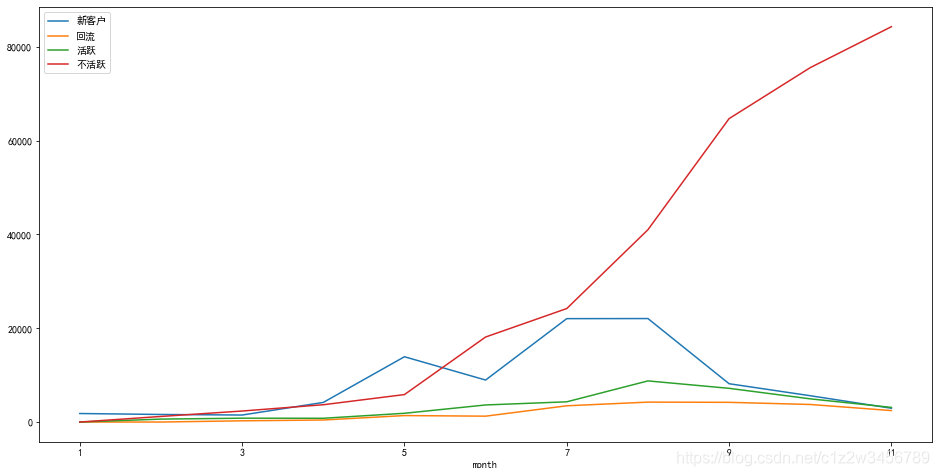
更多推荐
 已为社区贡献1条内容
已为社区贡献1条内容
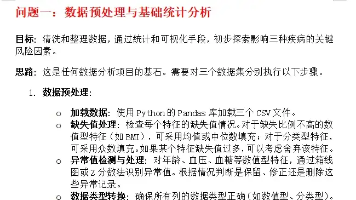






所有评论(0)